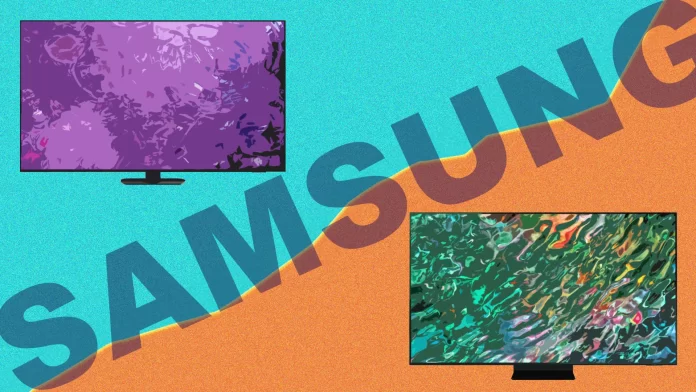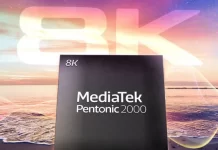The Samsung Neo QLED 4K QN90C and Samsung Neo QLED 4K QN90B share a striking resemblance, which is unsurprising considering they are part of the same series, with the Neo QLED 4K QN90C being the more recent addition. Both TVs have excellent picture quality, approaching the level of OLED TVs and surpassing them in brightness.
For easier readability, I will use “QN90C” and “QN90B” as shorter references for Samsung QLED 4K QN90C and QN90B.
When I compare the two models, I tend to favor the QN90C, mainly starting from the 55-inch size. It’s because, from the 55-inch size and upwards, the QN90C transitions to IPS panels, diverging from VA panels. For both the QN90C and QN90B equipped with VA panels, the distinctions in image quality become pretty negligible.
Given that both TVs share the same price point, the QN90C would be my preference. Nevertheless, if you come across a substantial discount on the QN90B, it’s worth considering, as it also stands out as a remarkable TV choice.
Specs and key info: QN90C vs QN90B
If you’re stuck choosing between the QN90C and QN90B, let’s break it down. At first glance, they seem pretty similar – both use Mini LED technology, share the same refresh rates, and have comparable prices. But there are some noteworthy distinctions.
The QN90C goes the route of adapting its panel type depending on the screen size. It employs VA panels for smaller sizes like 43 inches and 50 inches but switches to IPS-ADS for larger screens. In contrast, the QN90B sticks with VA panels across the board.
While both TVs come equipped with an anti-reflective coating and boast an ultra-viewing angle feature, it’s important to note that the QN90C truly excels in this regard, primarily due to its IPS panel, providing a much better viewing angle.
The QN90C is equipped with a Neural Quantum Processor 4K, while the QN90B flaunts a Neo Quantum Processor 4K. Performance-wise, I didn’t perceive any distinction, even though the QN90C operates on the Tizen 7.0 OS, whereas the QN90B utilizes Tizen 6.5. Both TVs ran smoothly, and I didn’t encounter any sluggishness in their operation.
The QN90B holds a slight edge in peak brightness, boasting 2080 cd/m² compared to the QN90C’s 1850 cd/m². However, during regular usage, the QN90C maintains an average brightness of 680 cd/m², while the QN90B’s average brightness is slightly lower at 640 cd/m².
Here’s a concise list of the key specifications for the QN90C and QN90B.
| Specs | QN90C | QN90B |
|---|---|---|
| Year | 2023 | 2022 |
| Display type | LED | LED |
| LED type | Mini LED | Mini LED |
| Panel Type | VA (43'' 50'' ) IPS - ADS (55'' 65'' 70'' 75'' 85'' 98'') | VA |
| Refresh rate | 140Hz (43'' 50'') 120Hz (55'' 65'' 75'' 85'' 98'') | 140Hz (43'' 50'') 120Hz (55'' 65'' 75'' 85'' 98'') |
| Resolution | 3,840 x 2,160 | 3,840 x 2,160 |
| Screen Size | 43'' 50'' 55'' 65'' 75'' 85'' 98'' | 43'' 50'' 55'' 65'' 70'' 75'' 85'' 98'' |
| Price | (43'' $1200) (50'' $1600 ) (55'' $2000) (65'' $2800 ) (75'' $3300) (85'' $4800) (98'' $15,000) | (43'' $1200) (50'' $1600 ) (55'' $1900) (65'' $2600 ) (75'' $3500) (85'' $5000) (98'' $15,000) |
| Picture Processor | Neural Quantum Processor 4K | Neo Quantum Processor 4K |
| Panel Bit Depth | 10 bits | 10 bits |
| Colors | 1073741824 colors | 1073741824 colors |
| Aspect Ratio | 16:9 | 16:9 |
| DCI P3 | 100% (percent) | 100% (percent) |
| Brightness | 680 cd/m² (candela per sq. meter) | 640 cd/m² (candela per sq. meter) |
| Peak Brightness | 1850 cd/m² (candela per sq. meter) | 2080cd/m² (candela per sq. meter) |
| Static Contrast (Dynamic Contrast) | 1750:1 (81,400:1) | 3050:1 (74,750:1) |
| HDR | HDR10, HLG, HDR10+, HDR10+ Adaptive | HDR10, HLG, HDR10+, HDR10+ Adaptive |
| Horizontal Viewing Angle | 178° (degrees) | 178° (degrees) |
| Vertical Viewing Angle | 178° (degrees) | 178° (degrees) |
| Average Response Time | 7.4 ms (milliseconds) | 7.2 ms (milliseconds) |
| Input Lag | 6.8 ms (milliseconds) | 6 ms (milliseconds) |
Picture quality face-off: QN90B vs QN90C
Regarding brightness, the QN90C consistently keeps things steady and high, whether you’re watching regular scenes or super bright ones. Now, the QN90B tends to go overboard by cranking up the brightness to levels that surpass what’s needed. Simply put, the QN90B might seem brighter than the QN90C, but it’s like turning up the volume too loud on your speakers – it can diminish the overall quality of what you’re experiencing on screen.
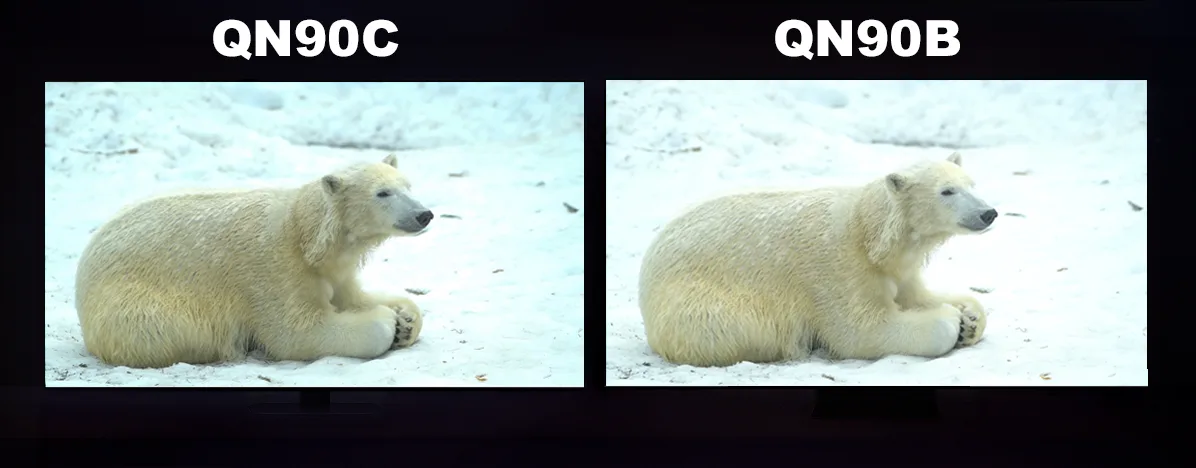
While native contrast ratio measurements may suggest lower performance for the QN90C, this does not hold true in real content. The QN90C’s superior local dimming compensates for the lower native contrast ratio, making it perform well in real-world scenarios.
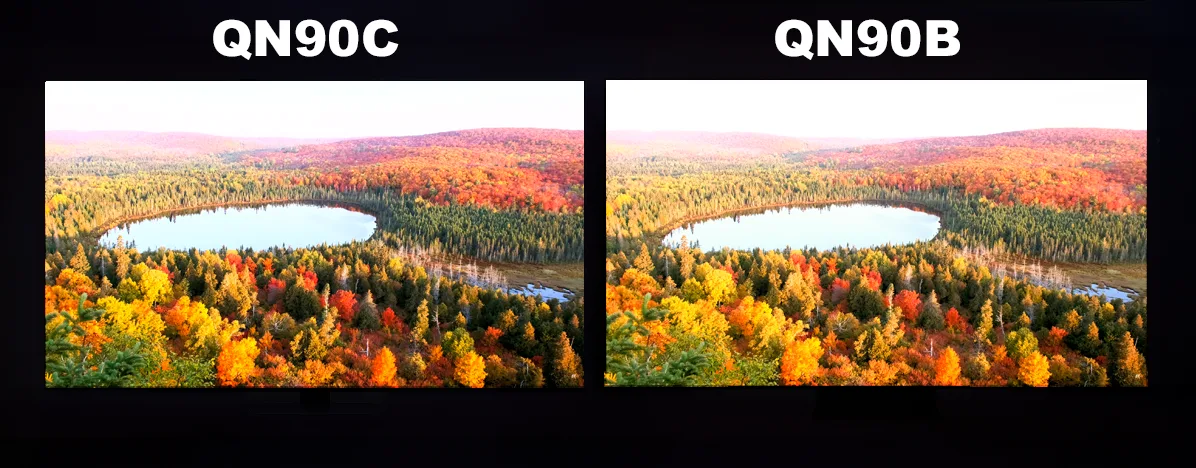
In those action-packed scenes, the QN90C nails it with finer details and contrast, outperforming the QN90B. Plus, when things get dynamic, the QN90C looks a bit smoother than the QN90B, hinting at better motion handling. Although, in the example below, you might not notice that extra smoothness.
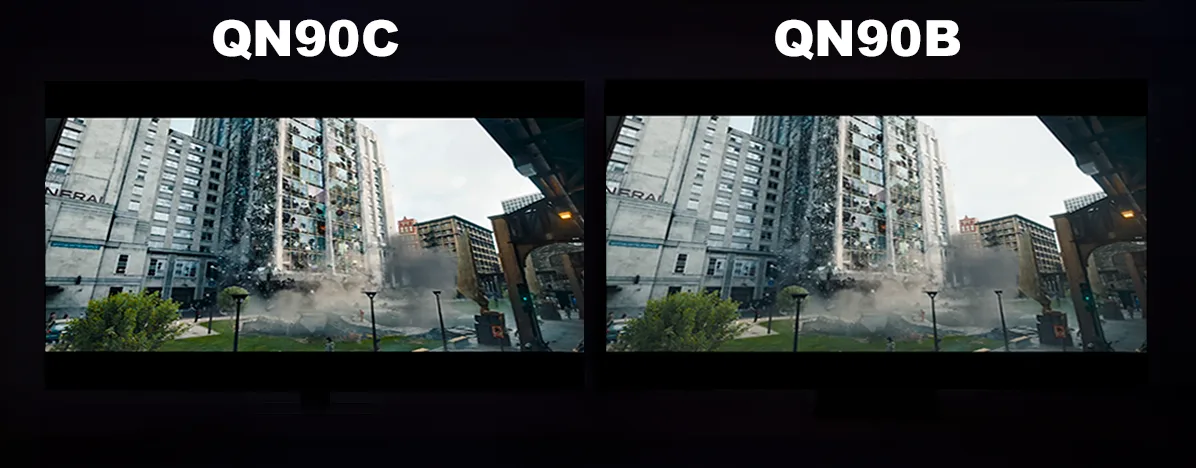
When it comes to those darker images, the QN90C really stands out. It does a better job highlighting those shadowy areas, and I’d say its color accuracy in those dark scenes is a tad superior to the QN90B.
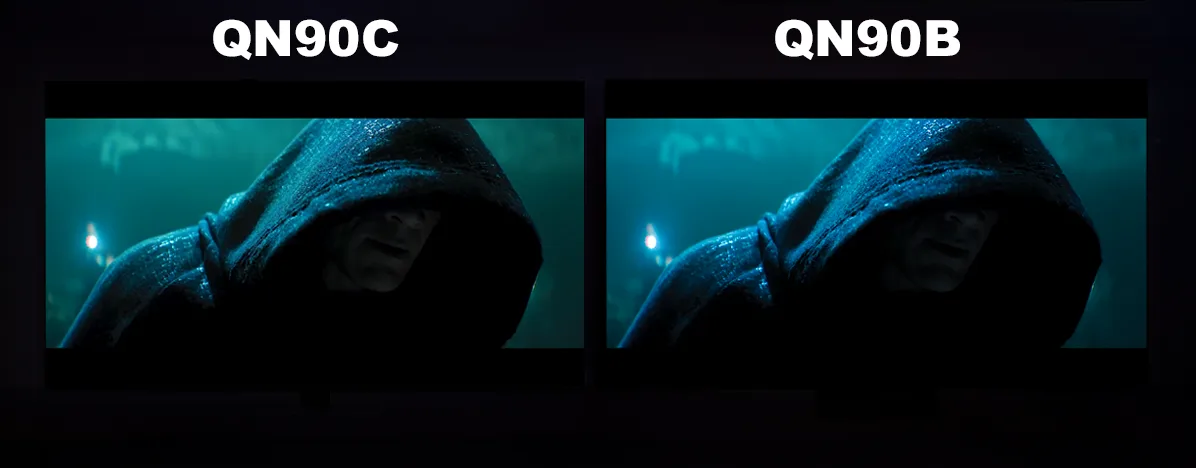
When you’re watching HDR 10 content, the QN90C truly stands out. It delivers brighter visuals and unveils more details than the QN90B. This difference becomes especially noticeable in those tough, demanding scenes.
Let’s dive into bloom control for a moment. Both TVs have quirks in this area, but the QN90C performs better than the QN90B. Even when both TVs are set to their most accurate settings, the QN90C handles colors more effectively.
If you look closely, you’ll notice those white dots have a faint bluish halo around them – that’s what we call the blooming effect. This effect becomes more pronounced as you view the TV from wider angles, so I snapped a picture from the side to showcase this blooming effect, which really gets on my nerves.
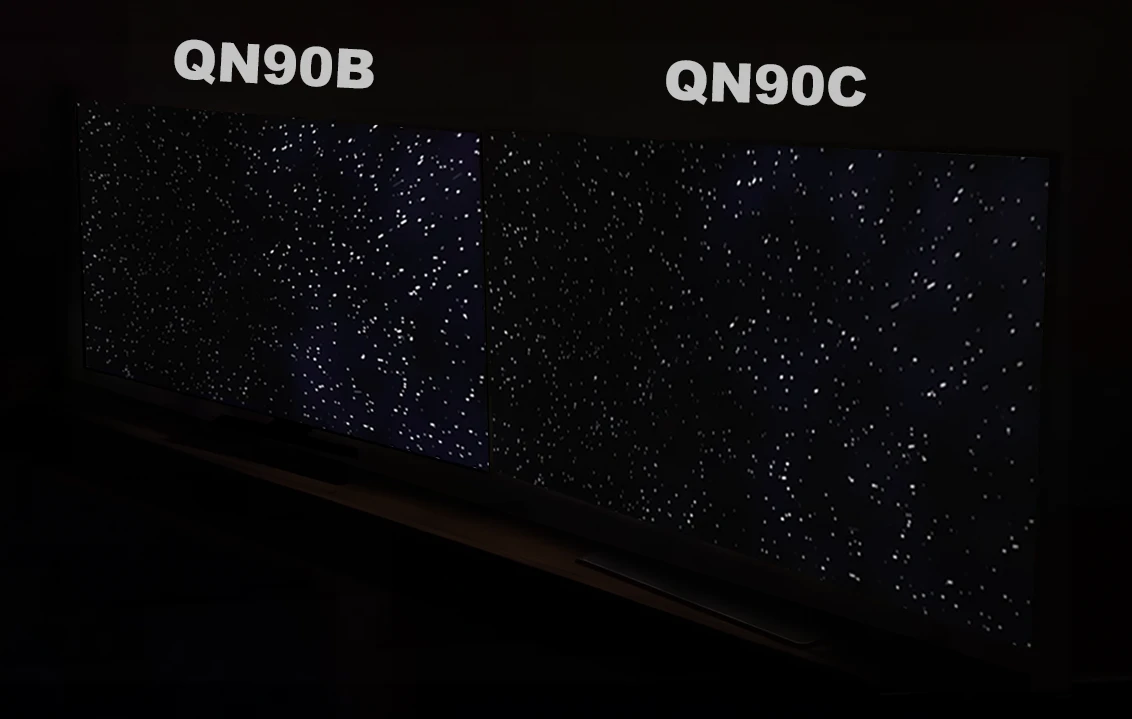
The QN90C offers a better viewing angle compared to the QN90B, thanks in part to its IPS (ADS) panel, as opposed to the QN90B’s VA panel, which isn’t known for its wide viewing angles.
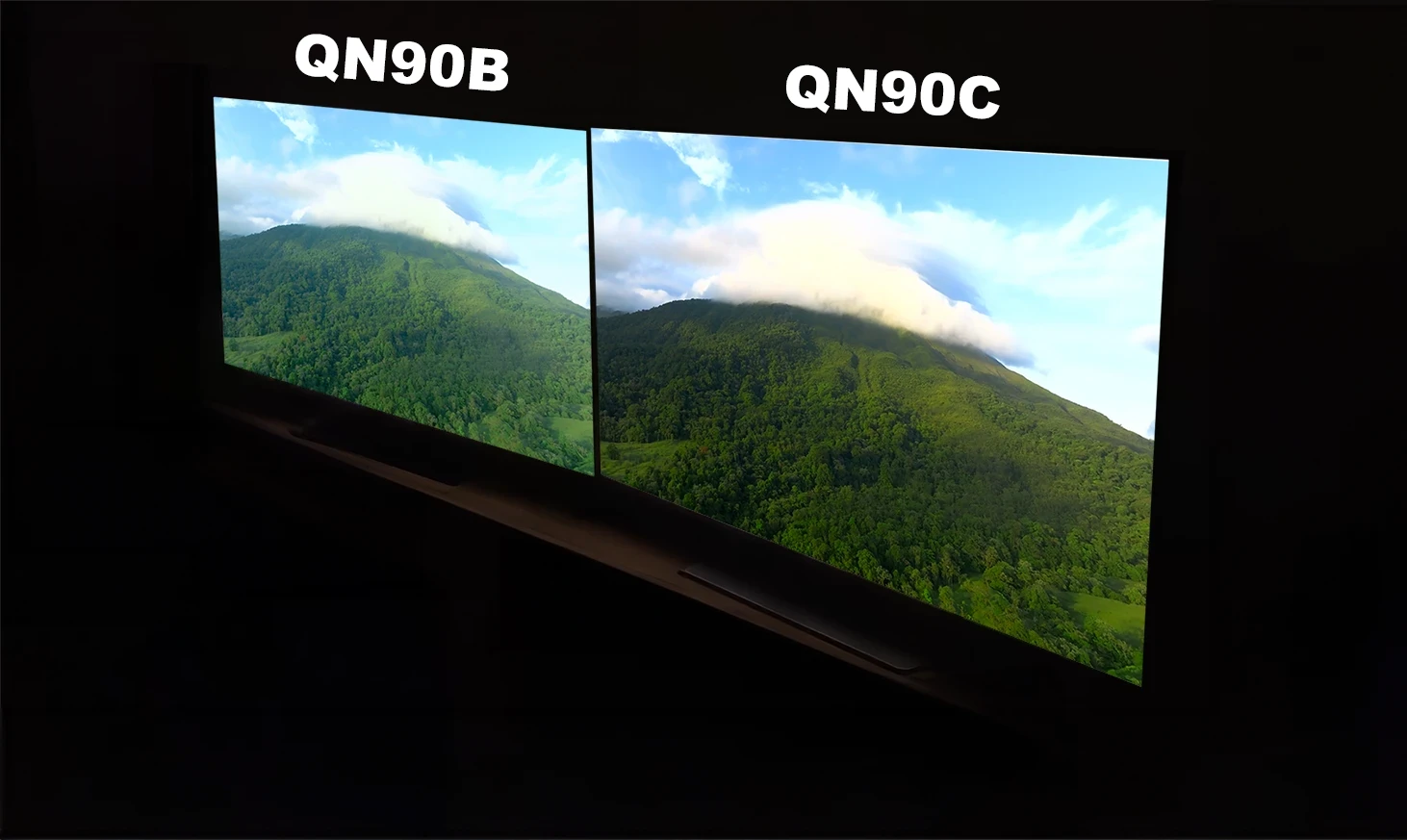
In a nutshell, both these TVs deliver outstanding picture quality. Most of my comments above, except for the viewing angles and color effects, are minor critiques rather than major differences in display quality. There were instances where I had to actively hunt for specific content just to spot any differences.
Video specs in QN90C and QN90B
Both the QN90C and QN90B models are pretty much the same when it comes to video features. They have the same resolution, HDR support, and max refresh rates for different screen sizes. But there’s one key difference: the QN90C B has an “Auto HDR Remastering” feature (AI technology automatically boosts SDR content’s contrast, colors, and brightness to match HDR levels.) that the QN90B doesn’t offer.
| Video Feature | QN90C | QN90B |
|---|---|---|
| Resolution | 3,840 x 2,160 | 3,840 x 2,160 |
| HDR (High-Dynamic Range) | Neo Quantum HDR+ | Quantum HDR 32X |
| Picture Processor | Neural Quantum Processor 4K | Neo Quantum Processor 4K |
| Viewing Angle | Ultra Viewing Angle | Ultra Viewing Angle |
| Film Mode | Yes | Yes |
| Adaptive Picture | Optimized/EyeComfort | Optimized/EyeComfort |
| HLG (Hybrid Log Gamma) | Yes | Yes |
| Contrast | Quantum Matrix Technology | Quantum Matrix Technology |
| Ultimate UHD Dimming | Ultimate UHD Dimming | Ultimate UHD Dimming |
| Contrast Enhancer | Real Depth Enhancer | Real Depth Enhancer |
| HDR10+ | Yes (ADAPTIVE/ GAMING) | Yes (ADAPTIVE/ GAMING) |
| Motion Technology | Motion Xcelerator Turbo+ | Motion Xcelerator Turbo+ |
| Anti-Reflection | Yes | Yes |
| Refresh Rate | 140Hz (43'' 50'') 120Hz (55'' 65'' 75'' 85'' 98'') | 140Hz (43'' 50'') 120Hz (55'' 65'' 75'' 85'' 98'') |
| One Billion Color | Yes | Yes |
| Auto HDR Remastering | Yes | N/A |
| Picture Clarity | Yes | Yes |
| AI Upscale | Yes | Yes |
| Filmmaker Mode | Yes | Yes |
| Brightness/Color Detection | Yes | Yes |
Samsung QN90C vs QN90B – design compare
The QN90C and QN90B share a sleek and quite similar design. The most noticeable distinctions are in their stands. The QN90C sports a broader base, while the QN90B boasts a more compact stand, which, in my personal preference, I find more aesthetically pleasing, even though it’s slightly less stable. Another difference is in the stand color – the QN90C features a Titan Black stand, whereas the QN90B opts for a straightforward black stand.
The screen thickness for both TVs measures 1.1 inches, except for the 98-inch version, which is 1.2 inches thick in both models.
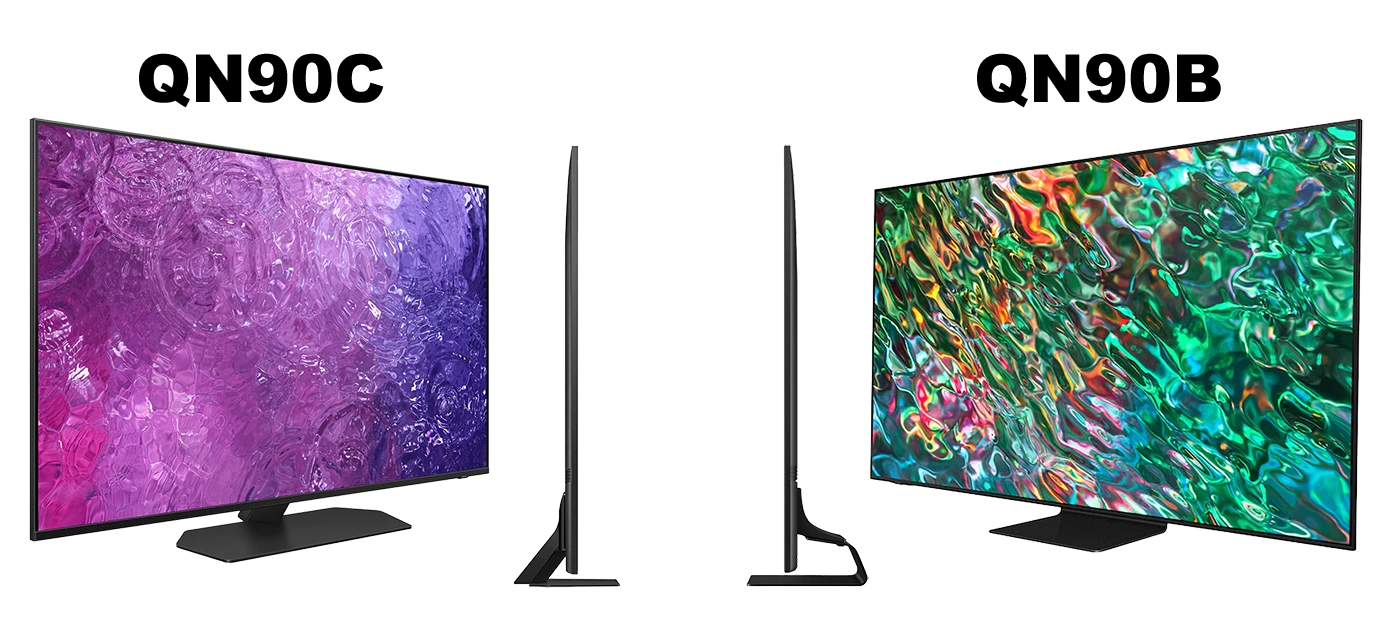
Here is QN90C and QN90B design specs:
| Design Aspect | QN90C | QN90B |
|---|---|---|
| Design | Neo Slim | Boldness |
| Color | Titan Black | Titan Black |
| Stand Type | Sharp Neck Hexagon | Bending Plate |
| Bezel Type | 4 Bezel-less | 4 Bezel-less |
| Slim Type | Flat look | Flat look |
| Stand Color | Titan Black | Sand Black |
| Front Color | Titan Black | Titan Black |
The remote controls for these TVs feature distinct designs. The QN90C’s remote is notably smaller than the QN90B’s. Nevertheless, their functionalities remain consistent, with the ability to charge them via a solar panel or USB Type-C, and both remotes include a microphone button. I favor the QN90B remote.
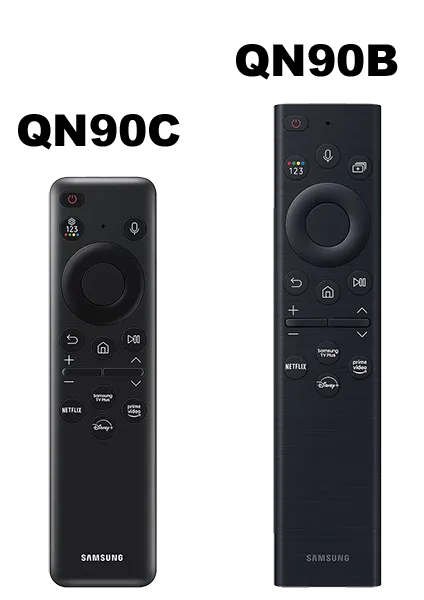
Sound comparison: QN90B vs QN90C
The audio performance of both TVs is nearly identical, and in certain instances, the QN90B even appeared to be louder than its counterpart. Regarding sound quality, it remains decent, partly attributed to the presence of Dolby Atmos technology.
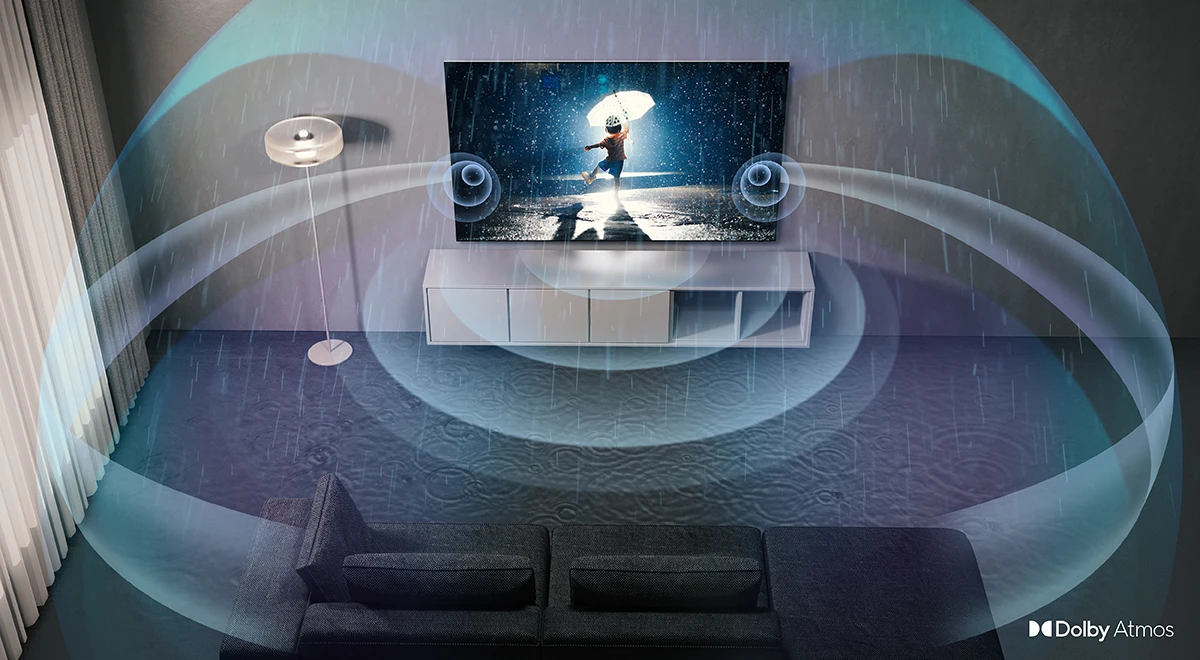
QN90C and QN90B Sound specs
Both the QN90C and QN90B have similar audio features like Dolby Atmos, 60W sound output, and Bluetooth Audio. The main difference is that the QN90C has a “Buds Auto Switch” feature to automatically switch to compatible earbuds, while the QN90B doesn’t have this.
| Audio Feature | QN90C | QN90B |
|---|---|---|
| Dolby Atmos | Yes | Yes |
| Dolby Decoder | MS12 5.1ch | 5.1CH |
| Active Voice Amplifier | Yes | Yes |
| Adaptive Sound | Adaptive Sound+ | Adaptive Sound+ |
| Object Tracking Sound (OTS) | OTS+ | OTS+ |
| Q-Symphony | Yes | Yes |
| Audio Pre-selection Descriptor | Yes | Yes |
| Sound Output (RMS) | 60W | 60W |
| Speaker Type | 4.2.2CH | 4.2.2CH |
| Woofer | Yes | Yes |
| Multiroom Link | Yes | Yes |
| Bluetooth Audio | Yes | Yes |
| Dual Audio Support (Bluetooth) | Yes | Yes |
| Buds Auto Switch | Yes | N/A |
Smart Services in QN90B and QN90C
Both TVs are loaded with an array of smart features, including voice assistants, web browsing, SmartThings integration, and the versatile Universal Browse & Play functionality. However, there’s a crucial distinction: the QN90C operates on the cutting-edge Tizen 7.0 OS, while the QN90B is still running Tizen 6.5. However, as I mentioned earlier, I didn’t notice any significant performance difference between the two.
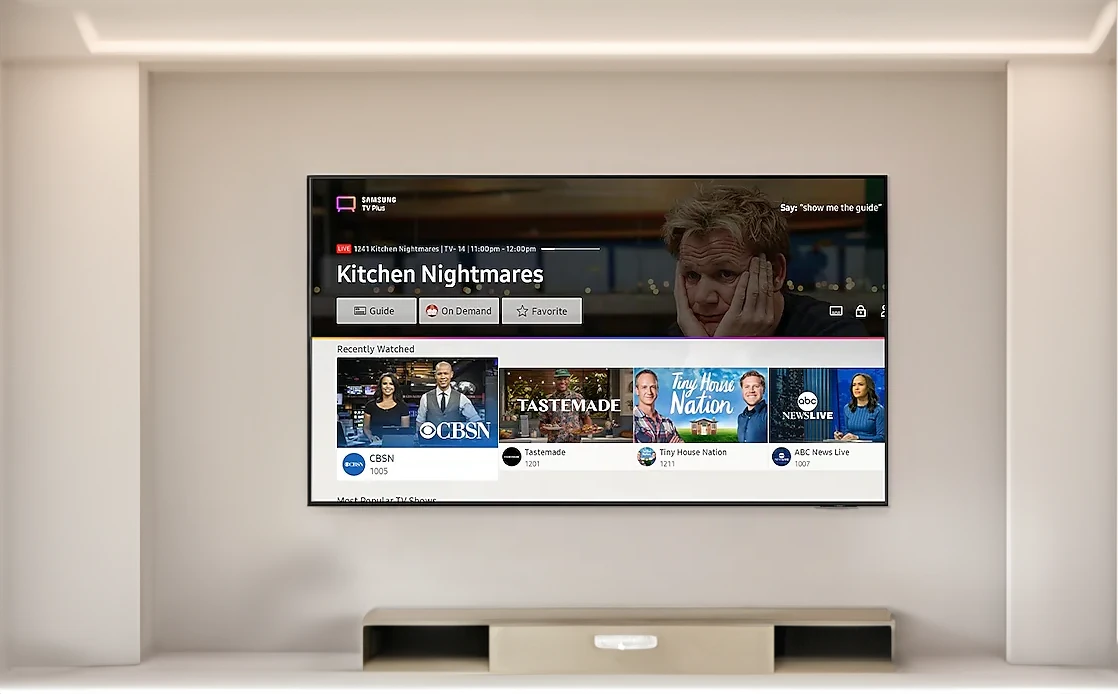
The QN90C has Alexa as its built-in voice assistant, while the QN90B goes with Google Assistant. But you can actually switch them around in the settings. So, you can make that change if you prefer Google Assistant on the QN90C or Alexa on the QN90B.
| Smart Service Feature | QN90C | QN90B |
|---|---|---|
| Operating System | Tizen 7.0 | Tizen 6.5 |
| Bixby | US English, UK English, Indian English, Korean, French, German, Italian, Spanish, BR Portuguese (features vary by language) | US English, UK English, Indian English, Korean, French, German, Italian, Spanish, BR Portuguese (features vary by language) |
| Far-Field Voice Interaction | Yes | Yes |
| Built-in Voice Assistant | Alexa (GB, DE, FR, IT, ES, AT, IE) | Google Assistant (GB, FR, DE, IT, ES, SE) |
| Multi Voice Assistant | Yes (GB, DE, FR, IT, ES, AT, IE) | Yes (GB, DE, FR, IT, ES, AT, IE) |
| Works with Google Assistant | Yes (GB, FR, DE, IT, ES, SE) | Yes (Built-in) (GB, FR, DE, IT, ES, SE) |
| Works With Alexa | Yes (Built-in) (GB, FR, DE, IT, ES, AT, IE only) | Yes (GB, FR, DE, IT, ES, AT, IE only) |
| TV Plus | Yes (GB, FR, DE, IT, ES, CH, AT, NL, SE, NO, DK, FI, PT, IE, BE, LU) | Yes (GB, FR, DE, IT, ES, CH, AT, NL, SE, NO, DK, FI, PT, IE, BE, LU) |
| Web Browser | Yes | Yes |
| SmartThings App Support | Yes | Yes |
| SmartThings | Yes | Yes |
| Universal Browse & Play | Yes (GB, FR, DE, IT, ES) | Yes (GB, FR, DE, IT, ES) |
Smart Features in QN90C vs QN90B
Both the QN90C and QN90B models are equipped with an extensive array of smart features, including but not limited to Multi-Device Experience, Mobile Tap Mirroring, Video Communication via Google Meet, Multi-View Support, and many others.
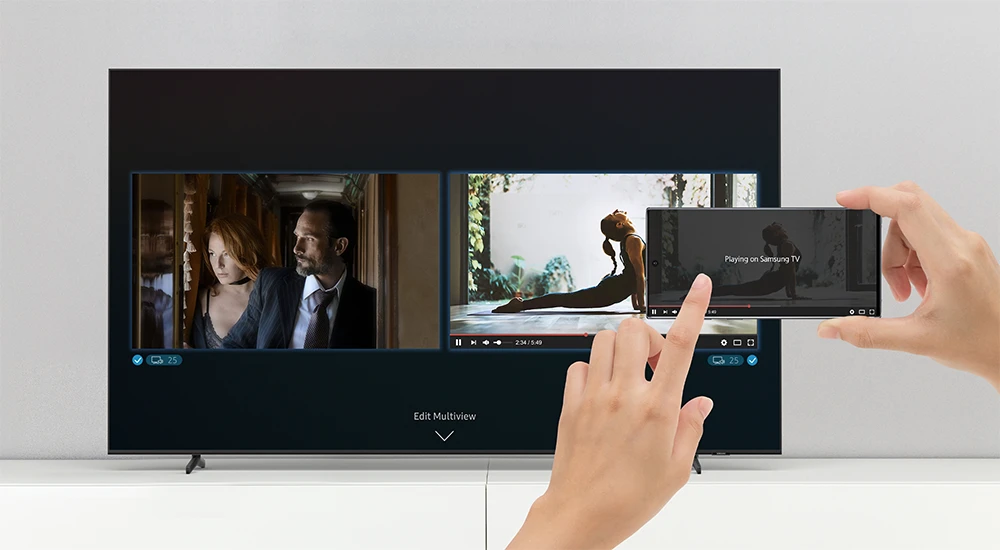
However, there are distinct differences that set the two models apart. Specifically, the QN90C model offers support for the NFT (Nifty Gateway) feature, which is absent in the QN90B model. Additionally, the QN90C includes a unique “Chat Together” functionality, although it is important to note that this feature is restricted to users located in the United States.
| Smart Feature | QN90C | QN90B |
|---|---|---|
| Multi Device | TV to Mobile - Mirroring, Mobile to TV - Mirroring, DLNA, TV Initiate Mirroring, Mobile Tap Mirroring, TV Sound to Mobile, Sound Mirroring | TV to Mobile - Mirroring, Mobile to TV - Mirroring, DLNA, TV Initiate Mirroring, Mobile Tap Mirroring, TV Sound to Mobile, Sound Mirroring |
| Mobile Tap Mirroring | Yes | Yes |
| Video Communication | Google Meet | Google Meet |
| Multi-View | up to 2 videos | up to 2 videos |
| Sound Wall | Yes | Yes |
| Mobile Camera Support | Yes | Yes |
| App Casting | Yes | Yes |
| Chat Together | Yes (US only) | N/A |
| Ambient Mode | Ambient Mode+ | Ambient Mode+ |
| Wireless Dex | Yes | Yes |
| Web Service | Microsoft 365 | Microsoft 365 |
| NFT | Nifty Gateway | N/A |
Gaming performance comparison: QN90C vs QN90B
Turning our attention to gaming, I set up an HDMI splitter with my PS5, enabling a simultaneous display on both TVs. This configuration provided a real-time comparison of their gaming performance under identical conditions.
Gaming performance: The QN90C steps up its game with improved local dimming when in game mode. Additionally, you’ll notice that the QN90C offers slightly better contrast in games, while the QN90B is a tad brighter during gaming. The QN90B is a bit brighter during gaming, but I’m not sure it’s a benefit for the in-game visuals.
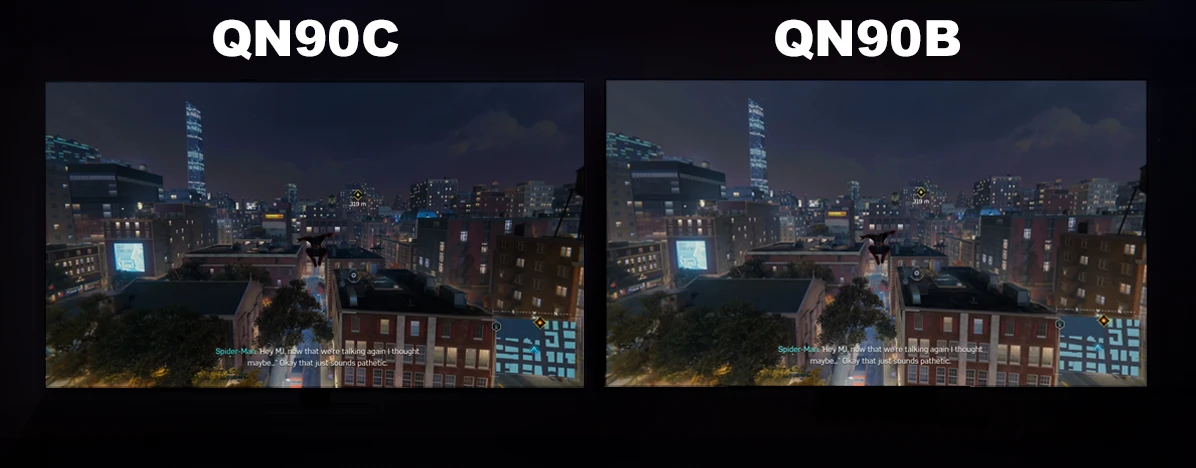
When it comes to brighter scenes, it’s pretty much a wash – there’s slightly higher contrast on the QN90C, but it’s barely noticeable.

In summary, I’d say these two TVs are virtually identical when it comes to gaming. They are both great with their 120Hz capability and FreeSync Premium Pro support, and here are all Game Features:
| Game Feature | QN90C | QN90B |
|---|---|---|
| Auto Game Mode (ALLM) | Yes | Yes |
| Game Motion Plus | Yes | Yes |
| Dynamic Black EQ | Yes | Yes |
| Surround Sound | Yes | Yes |
| Super Ultra Wide Game View | Yes | Yes |
| Game bar 3.0 | Game bar 3.0 | Game bar |
| Mini Map Zoom | Yes | N/A |
| Light-Sync | Yes | N/A |
| FreeSync | FreeSync Premium Pro | FreeSync Premium Pro |
| HGiG | Yes | Yes |
| Gaming Hub | Yes (KR, US, CA, BR, GB, FR, DE, IT, E) | Yes (KR, US, CA, BR, GB, FR, DE, IT, E) |
Connectivity feature in QN90C vs QN90B
Both the QN90C and QN90B models are on par when it comes to connectivity. They’ve got the same number of HDMI and USB ports, support 4K 120Hz, and come with Ethernet, Digital Audio Out, and CI Slot. Both also feature eARC, HDMI Quick Switch, built-in WiFi5, Bluetooth 5.2, and Anynet+ (HDMI-CEC).
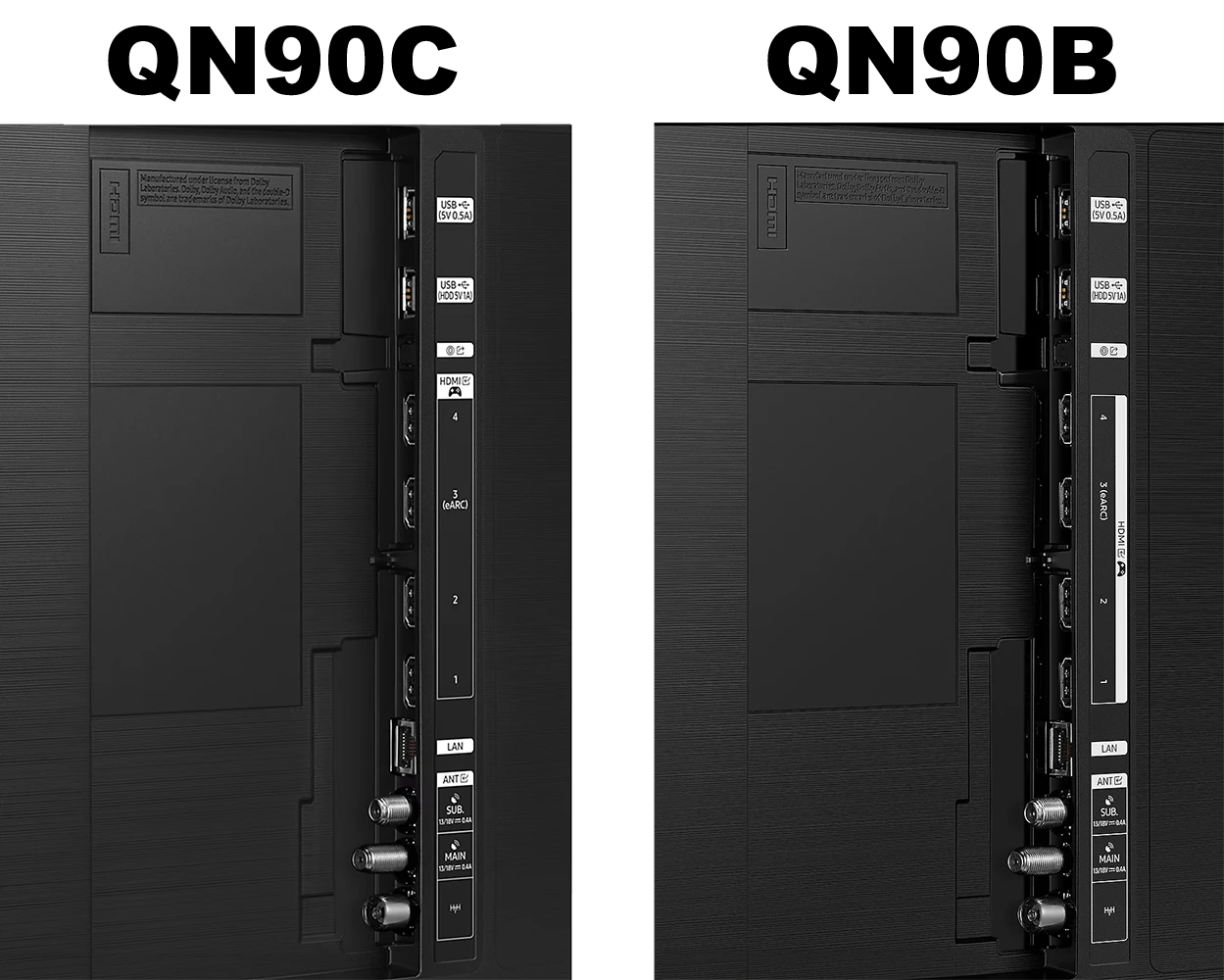
In short, there’s no difference in connectivity between the two.
| Connectivity Feature | QN90C | QN90B |
|---|---|---|
| HDMI | 4 | 4 |
| USB | 2 | 2 |
| HDMI (High Frame Rate) | 4K 120Hz (for HDMI 1/2/3/4) | 4K 120Hz (for HDMI 1/2/3/4) |
| Component In (Y/Pb/Pr) | N/A | N/A |
| Composite In (AV) | N/A | N/A |
| USB-C (Camera Only) | N/A | N/A |
| Ethernet (LAN) | 1 | 1 |
| Audio Out (Mini Jack) | N/A | N/A |
| Digital Audio Out (Optical) | 1 | 1 |
| RF In (Terrestrial / Cable input) | 1/1 (Common Use for Terrestrial)/2 | 1/1 (Common Use for Terrestrial)/2 |
| Ex-Link ( RS-232C ) | N/A | N/A |
| CI Slot | 1 | 1 |
| HDMI Audio Return Channel (eARC) | eARC | eARC |
| HDMI A / Return Ch. Support | Yes | Yes |
| HDMI Quick Switch | Yes | Yes |
| Wireless LAN Built-in | Yes (WiFi5) | Yes (WiFi5) |
| Bluetooth | Yes (BT5.2) | Yes (BT5.2) |
| Anynet+ (HDMI-CEC) | Yes | Yes |
QN90B and QN90C price comparation
Overall, the QN90C TV falls into the mid to upper pricing tier and isn’t typically considered a budget-friendly choice.
| Screen Size | QN90C Price |
|---|---|
| 43 inches | $1,200 |
| 50 inches | $1,600 |
| 55 inches | $2,000 |
| 65 inches | $2,800 |
| 75 inches | $3,300 |
| 85 inches | $4,800 |
| 98 inches | $15,000 |
Just like the QN90C, the QN90B TV belongs to the mid to upper price tier.
| Screen Size | QN90B Price |
|---|---|
| 43 inches | $1,200 |
| 50 inches | $1,600 |
| 55 inches | $1,900 |
| 65 inches | $2,600 |
| 75 inches | $3,500 |
| 85 inches | $5,000 |
| 98 inches | $15,000 |
In most cases, both models have identical pricing. However, there are a few instances where the QN90C is priced $200 lower and a few sizes where it’s $100 or $200 more expensive.
| Screen Size | QN90C Price | QN90B Price | Price Difference |
|---|---|---|---|
| 43 inches | $1,200 | $1,200 | $0 |
| 50 inches | $1,600 | $1,600 | $0 |
| 55 inches | $2,000 | $1,900 | $100 |
| 65 inches | $2,800 | $2,600 | $200 |
| 75 inches | $3,300 | $3,500 | -$200 |
| 85 inches | $4,800 | $5,000 | -$200 |
| 98 inches | $15,000 | $15,000 | $0 |
The prices of these TVs are generally on par, but it’s important to note that I’ve provided the official prices from Samsung without factoring in any discounts. Additionally, the costs on platforms like Walmart or Amazon could vary significantly from Samsung’s official pricing.

